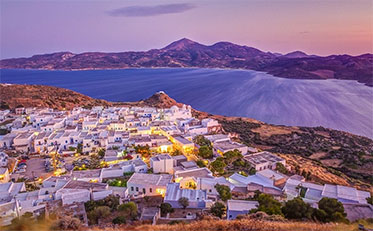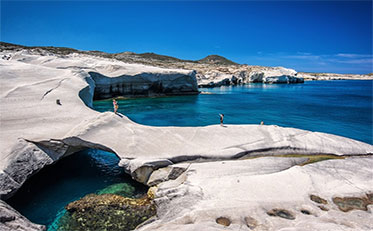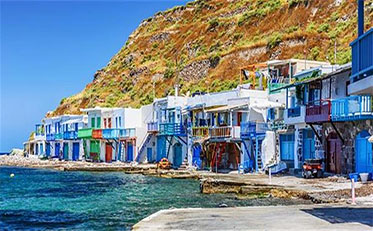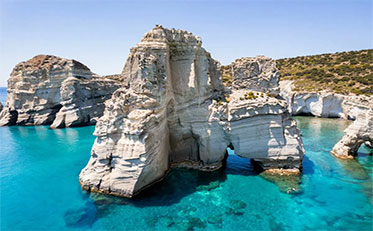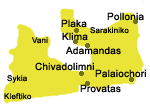|
Milos Island
Milos is the fifth largest island in the Cyclades. The horseshoe shaped island has a wide bay which is one of the largest natural harbours in the Mediterranean. It has volcanic origins and its surface has been transformed many times by volcanic eruptions. Geologically Milos is an extremely impressive place. Its hot medicinal springs are a result of these eruptions. The plain of Chora is fertile, but its small kitchen gardens and olive groves, which give colour to the volcanic landscape, cover only local consumption. The 4,500 inhabitants live off stock-breeding, fishing and tourism. Their spontaneous, open-hearted nature contrasts sharply with the rough and wild landscape. The island is famous for the statue of Aphrodite, (Venus de Milo), housed today at the Louvre museum in Paris. Milos offers the picturesque towns of Adamas, Apollonia and Plaka (Chora), the capital.
Milos is 5 nautical miles from Antimilos, or Erimomilos, an islet proclaimed a national park because of its chamois, a rare species of wild goat of brown color with a black stripe on its back which faces great survival problems. According to mythology, Milos was the name of the island's first settler who was sent there by Aphrodite from Cyprus. Filakopi, the island's oldest town which dates back to 3,000 BC, was one of the most significant cultural centers of the Cyclades. Milians took part in the Persian Wars on Greece's side. In Byzantine times, it belonged to the Theme of the Aegean and it was plagued by pirate raids like the rest of the Cyclades. After the fall of Constantinople, it passed to the Venetians, who kept it up until 1580. The pirate raids continued all through the Ottoman domination. In 1700 the pirate Ioannis Kapsis was elected "king of Milos", a title which he kept for three years. Milos took an active part in the Greek War of Independence of 1821. In 1835, Cretan revolutionaries from Sfakia established themselves on the island and founded the town of Adamas.
Place of interest: Geological museum, One of the most impressive in the world. Milos itself is a geological phenomenon. Species of volcano materials and hundreds of different Milos' "stones" are exposited. Archaeological Museum The Archaeological Museum of Milos has been housed, since 1985, in one of the most beautiful neoclassical buildings in Plaka, the so-called "Katastimata" (Shops). You can admire finds from various periods, ceramics, vessels decorated with flowers, idols of worship and sculptures from the Hellenistic and the Roman Periods. At the entrance of the museum lies a cast of the imposing statue of Aphrodite of Milos, which has been moulded in the reproduction workshops of the Louvre.
Kleftiko, or "Thalassina Meteora" (Sea Meteors), stands on the southern side of Milos. It is one of the most impressive landscapes in all of the Mediterranean with its huge boulders which spring up in asymmetric forms. During Byzantine times, it served as a pirate hide-out since it offered protection from storms. Cave of Papafragas, The Cave of Papafragas lies next to the archaeological site of Filakopi in Apollonia. It consists of two successive caves, only accessible by boat. These caves were used as pirate hide-outs during Byzantine times. Right across from the cave, one can see the huge rocks of Glaronissia, which form a cave from end to end with hexagonal pillars of lava hanging from its roof-like stalactites. Castle,The Castle of Milos is built on a conically shaped rock, 270 meters above sea. Accessible only to pedestrians willing to climb the steep steps. The Castle of Milos has no walls. The castle began to flourish during the last centuries of the Ottoman rule and after the liberation, it gave up its place to Plaka, the capital. It constituted the professional meeting place of all the famous Mediterranean pilots, who used to sit in a specific spot housed next to "portopoula", in order to watch the coming ships and be able to claim a position on one of them later. Catacombs,The catacombs of Milos are situated in a small fishing village called Klima, 2 km from Plaka. It is the only monument of its kind in Greece and constitutes one of the most significant finds from the early-Christian years. The entrance to the catacombs was destroyed in the 5th century BC, after a terrible earthquake, but it was accidentally rediscovered in 1840. The catacombs consist of long corridors in which the Christians used to find refuge or bury their dead. It is calculated that within the graves over 1,500 people must have been buried
Transportation By Air Daily flights from Athens airport (45 minute).
Sea lines Regular lines from Piraeus port. (87 nm) - 3 hours 30 minutes High-speed catamaran, 6 hours Ferry boats.
Also, regular ferry boat lines from Creta and Thessaloniki.
|
